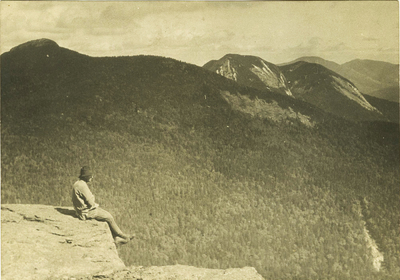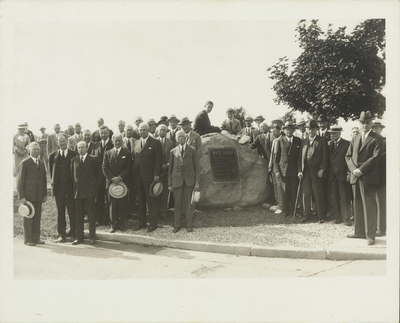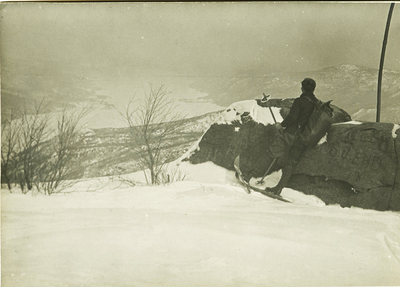Natural Enemies
American thought in the 19th Century led to the birth of the conservation movement. This movement eventually split into two opposing schools embodied by their respective leaders, Gifford Pinchot and John Muir. Pinchot’s ‘conservationists’ believed in a utilitarian approach, stating that land should be preserved for the economic value of what it could produce. Muir’s ‘preservationists,’ on the other hand, believed wild environments should remain untouched, preserved only for their natural beauty, scientific study, and recreation.
American attitudes toward wilderness and environmental politics are continually transforming. From Western colonization until the early 1800s, society viewed the wilderness as something dangerous; an enemy that needed to be mastered, dominated, and contained; an infinite resource created for man’s consumption.1 Even those that felt awestruck by the majestic beauty of the landscape also felt a moral duty to clear the land, impose order on it, and make it economically productive2— a view that is evident in James Fennimore Cooper’s 1826 novel The Last of the Mohicans3. It was not until the mid-19th century and the rise of Transcendentalism that this view would begin to change and the groundwork for conservationism was born.
In 1836, Ralph Waldo Emerson (1803-1882) published Nature, in which he argued that there was a spiritual reality higher than the physical that could be reached through the study of the natural world. Nature was a perfect medium to understand the divine because “nature is not fixed but fluid; to a pure spirit, nature is everything”.4 Transcendentalism prompted a new American perspective on the wilderness in which nature held intrinsic value, and had the ability to act as an antidote to the corrupting influence of society. This new view of nature led to the development of camping as a recreational activity—a chance to escape the oppressive influence of civilization and know one’s “true self”.
During the summer of 1858, Emerson, William James Stillman (Union College class of 1848), and eight other philosophers and artists traveled to Follensby Pond in the Adirondacks and built a rough camp out of natural materials. They stayed for one month, connecting to the spiritual power and beauty of the landscape. It was a transformative experience. Inspired by their surroundings, Emerson wrote the poem “The Adirondacks,” and Stillman painted “The Philosophers’ Camp in the Adirondacks”. The wide-reaching impact of these works elevated the prominence of the region. Soon, summering in the remote New York mountains was en vogue and a who’s who of Americans began visiting the region. Vanderbilts, Rockefellers, and Carnegies built ‘great camps’ (large, expansive estates) in the region. Over the following century, the popularity of vacationing in the Adirondacks would only grow.
In the footsteps of Emerson, two figures further shaped American thought on wilderness during the late 19th century: Henry David Thoreau (1817-1862) and John Burroughs (1837-1921). Thoreau, the father of American nature writing,5 famously wrote in his 1851 essay “Walking” that “in Wildness is the preservation of the World”.6 Thoreau believed that nature was our mother, imbued with incandescent perfection. Thus “man’s improvements, so called, as the building of houses and the cutting down of the forest… simply deform the landscape, and make it more and more tame and cheap”.7 Thoreau was an early proponent of both camping and canoeing, although he preferred “partially-cultivated country” to true wilderness. His essays on forestry and speeches at agricultural colleges sparked a dialogue on regulatory conservation.8
1 Nash, Roderick. Wilderness and the American Mind. (Yale University Press) 1982: 27
The emergence of the middle class in the Progressive Era (1890s-1920s) brought widespread social, political, and environmental movements to the American political landscape. The ideology of the middle class stressed science, professional expertise, and education.
During this period, John Burroughs became one of the foremost authors of nature writing, pushing the genre to its peak of popularity. Burroughs extolled Emerson’s work, stating that it was Emerson who opened his eyes to nature. However, Burroughs vociferously objected to being considered a disciple of Thoreau. He believed Thoreau’s romantic “associations with Nature vulgarize it and rob it of its divinity”.1
The cerebral quality of the Transcendentalist essays sometimes made them inaccessible to wider audiences. Burroughs’ approach to nature writing broadened its appeal. Utilizing close observations that led to large meanings, Burroughs’ unsentimental prose launched millions of readers into “nature to be soothed and healed, and to have [their] senses put in order”.2 One of the most popular writers in the United States, Burroughs directly impacted the national dialogue on conservation. He also influenced one of conservation’s loudest political proselytizers, Burroughs’s close friend, Theodore Roosevelt.
The growth of conservationism as a movement stemmed from the ecological consequences of American industrialism in the 19th and early 20th centuries. As the U.S. economy expanded, industries dug deep into the cache of natural resources. Logging, coal mining, and ranching stripped landscapes, poisoned the waters, and polluted the air. Americans watched their cities grow, their forests die, and their environments change. The ethics of conservationism revolve around three core principles: that human activity damages the environment; that there is a civic duty to maintain the environment for future generations; and that scientific, empirically based methods should be used to carry out this duty.
In 1897, a philosophical divide between the young conservation movement’s leaders, Gifford Pinchot and John Muir, created two often-clashing schools of thought: ‘conservation’ and ‘preservation’. Pinchot’s supporters co-opted the term ‘conservation’ and advocated for utilitarian conservation, while Muir’s camp advocated for ‘preservation’.
Utilitarian conservation focused on the economic value of what the land could produce. Pinchot distilled this view of utilitarian conservation into three core principles: development, preservation, and the common good.3 Pinchot defined development as constructing a system to “produce the largest possible amount of whatever crop or service will be most useful, and keep on producing it for generation after generation of men and trees;”4 preservation as “the prevention of waste… [as] the first duty of the human race is to control the earth it lives upon;”5 and the common good as the belief that “natural resources must be developed and preserved for the benefit of the many”.6
Theodore Roosevelt adopted these beliefs in regard to preserving wildlife for hunting, espousing the need to protect wild game from further destruction and eventual extinction.7 Roosevelt used his presidency to further the goals of conservationism by promoting “conservation as national duty,”8 designating nearly 230 million acres of land as bird and game reserves or national monuments, forests, and parks. Roosevelt appointed Pinchot as the chief of the newly created United States Forest Service, giving him the ability to promote as much commercial extraction of lumber as possible from the public lands.9
1 Burroughs, John. The Complete Nature Writings of John Burroughs. Vol. 8. New York: Wm. H. Wise &, 1904. 246
2 Ibid. 245
3 Pinchot, Gifford. The Fight for Conservation. (New York: Doubleday & Page) 1910.
4 Ibid. 45
5 Ibid. 48
6 Ibid. 66
7 Roosevelt, Theodore. The Wilderness Hunter. (New York: Collier & Son) 1893: 455.
8 Theodore Roosevelt, “Conservation as a National Duty” (speech, Conference of Governors, Washington D.C., May 13, 1908).
9 Ashley, Jeffrey S., and Marla J. Jarmer. The Bully Pulpit, Presidential Speeches, and the Shaping of Public Policy. 251
Muir and his preservationists, on the other hand, valued nature for its inherent spiritual and transcendental qualities. They argued that wild environments should be preserved for natural beauty, scientific study, and recreation without imposed human development. In order to combat the federally supported and powerful commercial forces of utilitarian conservation, the preservationists formed ‘associations’ so that they could stand toe-to-toe in their fight to preserve the wilderness.
Muir founded the Sierra Club in 1882 in order to protect the Sierra Nevada mountain range with the mission to:
To explore, enjoy, and protect the wild places of the earth; To practice and promote the responsible use of the earth’s ecosystems and resources; To educate and enlist humanity to protect and restore the quality of the natural and human environment; and to use all lawful means to carry out these objectives.1
Although many other outdoor recreation and conservation clubs had been formed since the 1870s, the Sierra Club is considered to be the first preservation-focused organization in the world to utilize political lobbying for environmental protection.
Preservation, the underdog of conservationism, was fiercely championed for generations by grassroots activist leaders such as John Muir (1838-1914), Aldo Leopold (1887-1948), John S. Apperson Jr. (1878-1963), Howard Zanhiser (1906-1964), Paul Schaefer (1908-1996), and many others. Their persistent efforts led preservation to overtake utilitarian conservation in mainstream, regulatory practice with the passing of the federal Wilderness Act of 1964.
John Apperson and Paul Schaefer crusaded to protect the wilderness for nearly a century, from Apperson’s arrival in New York in 1900 to Paul Schaefer’s passing in 1996. Apperson borrowed from John Muir’s Sierra Club organizational model to develop a productive, agile, and dynamic political operation. By building a network of environmental organizations, Apperson effectively fought the special interests that sought to exploit the Adirondack region. Behind the veil of these groups, he maintained personal anonymity while also deploying a wide base of active support when needed. With the combined power of these organizations, Apperson was able to engage in environmental debates at the highest level.
Apperson and Schaefer were passionate environmental advocates. Apperson described conservation as “his religion”2 and raised awareness through organizations, camps, guided hikes, retreats, documentary filmmaking and photography. Schaefer, a protégé of Apperson, declared wilderness to be a civil right. A gifted organizer, Schaefer had the ability to unite factious groups. He brought countess new advocates to the preservationist cause, helped shape a national campaign to preserve the wilderness, and built a foundation for the future of New York environmentalism.










